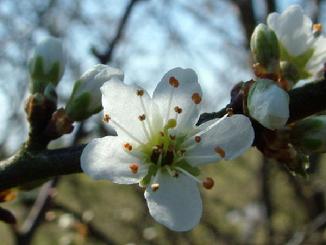There is no flower on earth that better symbolizes the O'Sullivan Clan than the Blackthorn Rose. Its blossom is elegantly simple. Its white petals celebrate the clan's purity of spirit and intent. The rugged Blackthorn Tree blossoms in the dead of winter, when most other plants are in full retreat from the bitter cold.
"Blackthorn has a habit of covering its bare branches with clouds of snowy white, little, fairy flowers before it has even started to push out its leaves. This can happen any time from February to April, depending on local conditions. In rural areas, this time of the year is still known as the 'Blackthorn Winter'.
Just as the warmest months of the year usually occur after Midsummer day, so the coldest months of the year can be expected after Midwinter. More often than not we find therefore, that in the early months of the year, when the cold North East Winds may still be with us, most of Nature is cautiously holding back its growth, save a few brave heralds of stirring life. All the crowns of the trees are still empty, gloomy and leafless.
And then the magic happens: The Blackthorn bursts out in an abundance of blossoms. It defies the tyranny of low temperature in a breath-taking spectacle of a myriad of white tender flowers. Life has come back from the death of winter once more.
Robert Graves noted that the ancient Celtic name for Blackthorn, "Straiff", is related to words such as 'strive' and 'strife'. Sloe (the fruit of the Blackthorn) and 'slay' may also be closely connected in early English.
Blackthorn is the traditional wood to make fighting sticks, because, like other woods in the Rosaceae family, it is tough and hard. The traditional Irish shillelagh or cudgel is one example of a weapon made with this wood.
In the cultivated Rose, the symbolism often focuses on the voluptuous flowers. In the Blackthorn, it focuses more on the thorny side of life. There is an element in the ancient Celtic naming of this 'Strife Tree' that acknowledges the belligerent, struggling spirit of this species: its colonizing habit, its defensive thorns, its ability to bloom in harsh weather."
Adapted from The Tree Tribe Website
The blackthorn rose is carved into the center of the stone mantle in the grand salon of Dunderry Chateau du Gravier, the O'Sullivan castle. It is flanked by oak and holly, other sacred trees of the Celts.
|
 |
| The Blackthorn Rose |
|
|